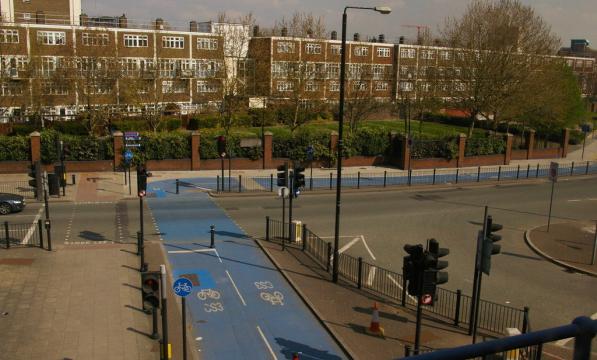New Cycle Superhighways in London – but what of the rest of the UK?

This Saturday marks the opening of two of the Mayor of London’s grand cycling schemes – the last two before the end of Boris Johnson’s time in office. They are testament to the hard work of the Mayor to make cycling a safe, enjoyable activity, accessible to all.
The East-West (CS3) and North-South (CS6) Cycle Superhighways criss-cross the capital, unlocking key arteries in London’s road network to the burgeoning cycling community.
The CS3 route runs from Tower Hill in the east of the city to Lancaster Gate, along the Victoria Embankment via Parliament Square. A later phase of the East-West superhighway will then continue to Acton via the Westway flyover. The CS6 route runs from Elephant & Castle to Farringdon via Blackfriars Bridge, with a later continuation planned to Kings Cross.
Both routes are significant for a number of reasons. Firstly, they are made up largely of kerb-separated bi-directional cycle lanes, completely segregated from motorists. These tracks provide the kind of protection from motor vehicles which feel safe and convenient for anyone to cycle, including children, older people and people with disabilities.
Secondly, the tracks have involved the re-allocation of road space from cars to cyclists. Research has shown that reducing road-space for motorists is a wonderfully effective method for reducing overall motor-traffic volume – having the knock-on effect of creating a more cycle-friendly city as a whole.
One down-side of the bi-directional lane is the requirement for cyclists to cross the entire road if they wish to turn a particular way. While individual tracks on either side of the road are the best way of mitigating the risks involved, the current development is a huge improvement from having to make these kinds of manoeuvres in the midst of four lanes of motor traffic.
CS3 is particularly notable for its route, passing by Parliament Square. Parliament Square is a notorious accident hot-spot for all road-users. Only last month the air ambulance made an emergency landing on College Green, to attend to an elderly woman who collided with a bus.
Of equal importance however, is the iconic location. Parliament Square is in the very centre of Britain’s throbbing political heart. The track can act as a glowing example to politicians – from local Councillors to foreign dignitaries – of best practise in cycling provision. It also gives a clear message to the international community – that Britain is taking cycling seriously.
However, if you look beyond the capital, you’d be forgiven for believing this is far from the case. You only have to go as far as Colchester, to see cycle infrastructure being built that actually creates worse conditions for people wishing to cycle. ]
The only way to ensure that all new cycle infrastructure is of a high standard is to have national design standards – like those outlined in Wales. Match this with sufficient funding and – only then – will we have the potential to see the Prime Minister’s 'cycling revolution' in action across the UK."
Tom Guha, Space for Cycling Campaigns Officer
On the Mile End Road, cyclists have been directed onto the footway to a shared space with pedestrians. When concerns were raised about pedestrian/cyclist conflict, made worse by the steep incline causing cyclists to gain speed, a Freedom of Information document outlined Essex County Council’s masterplan:
“The facility will have features which will naturally check the speed of cyclists; these will include road signs, trees, lighting columns, bus stops and deviation of route at side roads”.
This kind of infrastructure does nothing to benefit active travel and serves only to encourage motor vehicle use.
Unlike Essex, new cycle infrastructure in London is of a consistently high standard. There are two reasons for this; funding and design standards.
The Mayor of London has allocated £18 per head for cycling annually. By contrast the Department for Transport has announced just £300 million for cycling across the rest of the UK for the next four years, equating to an average annual spend of just £1.39 per head, but in reality will sink to just 72p in its final year.
London also has clear design standards which set a clear framework for the construction and assessment of new cycling provision. These act as a guideline for any new cycle infrastructure being built in London.
There are some excellent examples of cycle infrastructure outside of London. A route in Rusholme, Manchester, was recently built which follows very similar principles as those in London. However there are also many more Colchesters. The new Leeds-Bradford cycle route is a prime example.
The only way to ensure that all new cycle infrastructure is of a high standard is to have national design standards – like those outlined in Wales. Match this with sufficient funding and – only then – will we have the potential to see the Prime Minister’s “cycling revolution” in action across the UK.
Tell your Councillors to support our Space for Cycling campaign to demand better funding and design standards.

